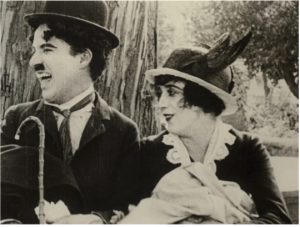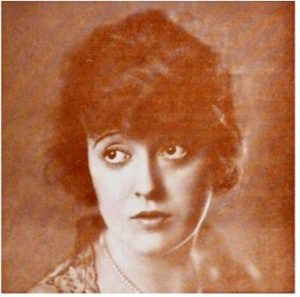AFI Catalog Spotlight: Mabel Normand
This November, the AFI Catalog shines a spotlight on Mabel Normand, who was born this month in 1892 (by most accounts), and who was one of the first actresses to start her own Hollywood production company and to direct herself in films. Beginning her career in modeling as a “Gibson Girl,” Normand became a leading performer in film without a background in vaudeville or theater, which was unusual at the time, and she was one of the first actresses to be named in her film titles, the first of many being MABEL’S LOVERS in 1912. She also worked for the preeminent film studios of her time, including Biograph (as part of D. W. Griffith’s coterie), Vitagraph and Keystone, where she developed her slapstick chops with the Keystone Kops, and even, in old-time-melodramatic fashion, got tied to the railroad tracks in arguably the first portrayal of this iconic scene. Samuel Goldwyn cast her as the perfect insouciant tomboy in his 1918 success, PECK’S BAD GIRL, and this spitfire character became a hallmark of her work. Normand, who commonly portrayed empowered women, also performed many of her own stunts, from daring horseback riding to being dragged through the mud clinging to rope.
 Normand was also Hollywood’s top comedienne. She starred in dozens of films with Charlie Chaplin and with Roscoe “Fatty” Arbuckle, some of which she co-wrote and co-directed, and she is credited by historians as having a significant influence on their careers. But Normand equally succeeded on her own. Normand’s personal showpiece, MICKEY, produced by her own company, was the highest-grossing feature film of 1918. She starred in Mack Sennett’s THE EXTRA GIRL, from 1923, one of the quintessential comedies about small-town dreamers coming to Hollywood to “make it” in the movies. In all, Normand made roughly 170 shorts—directing at least 15 of them—and 23 features. Film history accounts for the pantheon of sainted silent comics: Chaplin, Buster Keaton, Harold Lloyd, and a distant fourth, Harry Langdon, (whom some critics have likened to a male Mabel Normand), and yet Normand’s vast contributions to early filmmaking have gone relatively disregarded in comparison.
Normand was also Hollywood’s top comedienne. She starred in dozens of films with Charlie Chaplin and with Roscoe “Fatty” Arbuckle, some of which she co-wrote and co-directed, and she is credited by historians as having a significant influence on their careers. But Normand equally succeeded on her own. Normand’s personal showpiece, MICKEY, produced by her own company, was the highest-grossing feature film of 1918. She starred in Mack Sennett’s THE EXTRA GIRL, from 1923, one of the quintessential comedies about small-town dreamers coming to Hollywood to “make it” in the movies. In all, Normand made roughly 170 shorts—directing at least 15 of them—and 23 features. Film history accounts for the pantheon of sainted silent comics: Chaplin, Buster Keaton, Harold Lloyd, and a distant fourth, Harry Langdon, (whom some critics have likened to a male Mabel Normand), and yet Normand’s vast contributions to early filmmaking have gone relatively disregarded in comparison.
This may be a result of the misfortune that Normand’s career was tainted by scandal. Through no fault of her own, her name was connected to two sensational murders, including that of her close friend, director William Desmond Taylor. She was also known to have struggled with drug addiction. However, she continued working with Hal Roach, and most likely would have added many more plaudits to her career had she not contracted tuberculosis and prematurely retired from the film industry at the end of 1926. She died less than four years later in a Monrovia sanatorium.
 Mabel Normand can be fondly remembered today because some of her films have survived. Her doe-eyed beauty, innocent playfulness and gamin-like charisma remain undimmed by a passing century. She clearly inspired Italian actress Giulietta Masina in such films as LA STRADA. Singer Stevie Nicks wrote and recorded a song about her, and Normand has popped up in modern pictures (CHAPLIN, portrayed by Marisa Tomei), on TV (she’s mentioned in DOWNTON ABBEY), and on Broadway (MACK AND MABEL, portrayed by Bernadette Peters). The scope of Normand’s contributions to early cinema, and the legacy that followed, has been the subject of vast scholarly review, as her writing and directing credits are presumed to be much more substantial than what was credited onscreen. Normand’s distinctive charm and comedic genius have inspired generations of storytellers, and her work has not aged over time. As younger audiences continue to fall in love with Mabel Normand, she will take her rightful place in film history as its foremost pioneer.
Mabel Normand can be fondly remembered today because some of her films have survived. Her doe-eyed beauty, innocent playfulness and gamin-like charisma remain undimmed by a passing century. She clearly inspired Italian actress Giulietta Masina in such films as LA STRADA. Singer Stevie Nicks wrote and recorded a song about her, and Normand has popped up in modern pictures (CHAPLIN, portrayed by Marisa Tomei), on TV (she’s mentioned in DOWNTON ABBEY), and on Broadway (MACK AND MABEL, portrayed by Bernadette Peters). The scope of Normand’s contributions to early cinema, and the legacy that followed, has been the subject of vast scholarly review, as her writing and directing credits are presumed to be much more substantial than what was credited onscreen. Normand’s distinctive charm and comedic genius have inspired generations of storytellers, and her work has not aged over time. As younger audiences continue to fall in love with Mabel Normand, she will take her rightful place in film history as its foremost pioneer.
Learn more at the AFI Catalog.